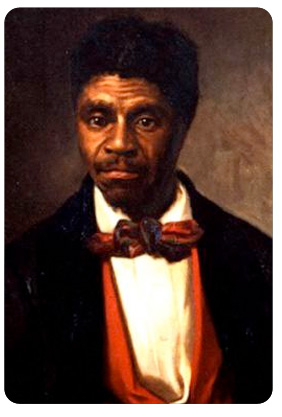America
Louis Schultze
Missouri Historical Society
Portrait Description
Looking out at the viewer with a slightly furrowed brow, this now-iconic portrait of Dred Scott depicts a pensive individual. The white shirt, red vest, and bow tie give energy to this somber portrait of a man who, although having experienced suffering and adversity, retained his dignity and resolve. This painting by the artist Louis Schultze was commissioned by a "group of Negro citizens" and presented to the Missouri Historical Society, St. Louis, in 1882. It is thought to be based on the only known photograph of Dred Scott, probably taken in 1857.
Seeking Freedom
Dred Scott was born into slavery in Virginia sometime around 1800. Exact dates are not known. In about 1830 he moved to Missouri with his owner Peter Blow, who had relocated his family to St. Louis. A few years later, Scott was sold to Dr. John Emerson, an Army surgeon. The transfer of ownership occurred prior to December 1, 1833, when Dr. Emerson reported to Fort Armstrong in Illinois, bringing with him his slave Dred Scott. Later, Emerson was assigned to Fort Snelling in the Wisconsin territory. Under the Missouri Compromise of 1820, Wisconsin was a free territory. After several other postings, Emerson settled in Iowa, where he died in 1843. Emerson’s widow and child returned to St. Louis shortly thereafter. At that time, Dred Scott and his wife, Harriet, were in St. Louis, most likely hired out to someone else. On April 6, 1846, Dred and Harriet Scott filed petitions against Irene Emerson seeking their freedom, based on their time living in the free state of Illinois and the free territory of Wisconsin. The Scotts lost the case, but a new trial was granted, which they won. An appeal went to the Missouri Supreme Court, which reversed the lower court decision. At that point, Roswell Field, now representing Dred Scott, moved the case to the United States District Court. Field actually was looking for the case to go to the United States Supreme Court. At Field’s request, Montgomery Blair, a Missouri attorney practicing in Washington, D.C., agreed to present the case to the Supreme Court.
National Implications
The Supreme Court decision, delivered in 1857 by Chief Justice Roger Taney, did not limit itself to the issue of freedom for Dred Scott. In that regard, Taney noted that Dred Scott was not a citizen, had no status to sue, and thus was not free. But Taney did not stop there. For whatever reason, the Chief Justice of the United States decided that his opinion should deal with a much broader issue. He noted that a slave was chattel (a piece of property) and thus, like one’s suitcase or one’s horse, could be taken anywhere in the United States where that property was not illegal. This simple ruling invalidated the Missouri Compromise and, to an extent, the Compromise of 1850 and the Compromise of 1854 (Kansas-Nebraska Act). It opened all unorganized territories of the United States to slavery. If Chief Justice Taney thought that he was settling the slavery issue, he was emphatically wrong. While his decision was cheered by pro-slavery forces, the abolitionists became even more fervent in their opposition to the institution of slavery.
After the decision, the ownership of Dred Scott and his family were deeded to his former master’s son Taylor Blow. He then emancipated them through manumission at the St. Louis Court House. The Blow children had spent their childhood with Dred. Many years later, during the ongoing litigation, they covered some of the Scotts’ legal expenses. Dred lived less than a year after being freed. His wife, Harriet Robinson Scott, and their daughters remained in St. Louis. Harriet is listed in various census records. Although there are no specific documents recording her death, 1876 is the date generally accepted.
top^
next artifact}
|

|




 Dred Scott, 1882
Dred Scott, 1882